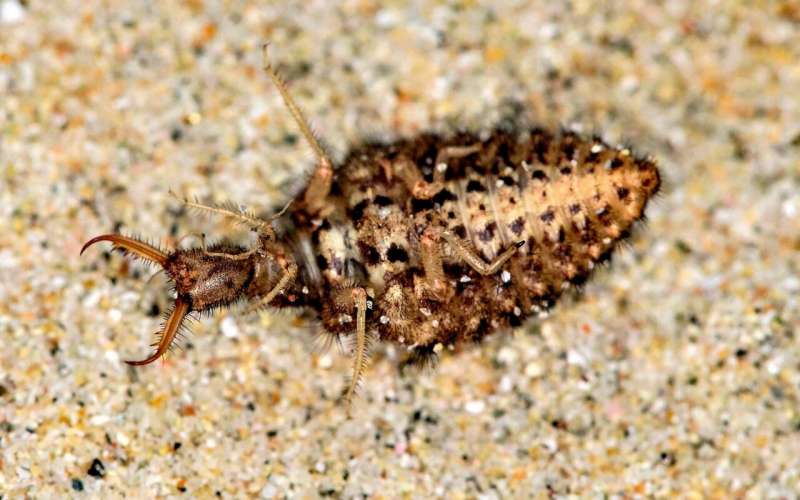This article has been reviewed according to Science X's editorial process and policies. Editors have highlighted the following attributes while ensuring the content's credibility:
fact-checked
peer-reviewed publication
trusted source
proofread
Life after (feigned) death: Study finds context-dependent behavior in antlions after 'playing possum'

A study led by scientists from the University of Bristol reveals what animals do after they have feigned death in order to avoid being killed by a predator and what the context of this behavior is. The work has been published in PLoS ONE.
Many animals, as a last-ditch defense, become motionless after being contacted by a predator.
This behavior is so common that it's recognized in such phrases as "playing possum." It is even said to occur in humans in extreme circumstances.
In previous studies, carried out by the same team using antlion larvae, scientists noticed that they become motionless after being individually handled.
At one point, the larvae needed to be weighed, which with such small insects can be very difficult. If they move on the pan of the weighing balance, determining their mass can be a challenge.
However, when the antlion larvae were dropped, very gently, onto the pan of a weighing balance, they remained completely stationary for more than enough time for their weight to be recorded accurately.
Emeritus Professor Nigel Franks from the University of Bristol's School of Biological Sciences, who led the study, said, "We chose to investigate this so-called 'death-feigning' behavior and we found that the amount of time individual antlions remain stationary is completely unpredictable for any one individual.
"This is confirmed by looking at the durations of post-contact immobility in a large number of antlions. Such data shows an exponential distribution. So, just as with radioactive atoms, when an individual changes state is unpredictable, but the population pattern is perfectly predictable."
The study shows that the behavior of antlions hiding in plain sight, in this way, is likely to be adaptive because a predator, having picked up and then dropped an antlion larva, could not know how long to wait for its potential victim to move again and once more become a recognizable prey item. Indeed, one of the antlions recorded remained completely stationary for more than an hour.
Even though it cannot be predicted when a motionless antlion will spring back to life, this does not mean that the predator will necessarily have left the scene to look for alternative prey.
The team's next question was what animals do after playing possum. In the new study, they show that what antlions do depends on the situation in which they find themselves.
Antlion larvae are burrowing animals and might seek safety by submerging into the friable substrate where they normally build their pits. But it is quite possible that a predator might drop an antlion on to a hard substrate that wouldn't permit escape through borrowing.
By using sophisticated automated video tracking of the intermittent locomotion of individual antlions on different substrates, researchers found that what an antlion does after terminating its period of motionlessness depends on what escape strategies are available.
Professor Franks added, "Our study might well be the first to determine what animals do after they have played dead, and we show that what they do is context dependent. It is a trade-off. So, our work opens up the field of studying life after death in the huge range of animals that exhibit death feigning, thanatosis or what we prefer to call post-contact immobility."
More information: 'Seeking safety: Movement dynamics after post-contact immobility', PLoS ONE (2024).
Journal information: PLoS ONE
Provided by University of Bristol




















